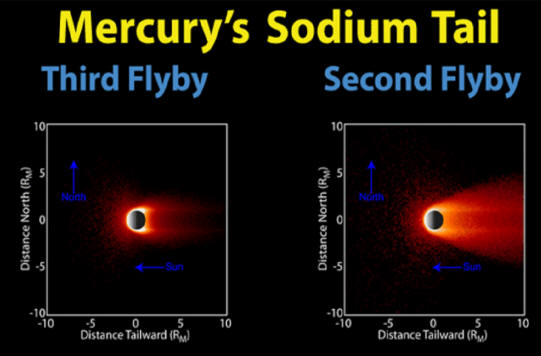|

MESSENGER space probe data reveals
Mercury's sodium tail varies in
size.
Credit: NASA/Johns Hopkins
University Applied Physics
Laboratory
and the Carnegie Institution of
Washington
Son of Marduk
Apr
21, 2011
Mercury's tail represents another
"unexpected" result when planetary
scientists ignore plasma physics.
According to Electric Universe
theory, comet tails are created when
the cometary plasma sheath
accumulates enough electrical
potential to discharge, causing it
to glow. Irrespective of their
individual composition, comets obey
the fundamental behavior of charged
objects within a plasma shell.
Earth's cometary plasma cocoon,
otherwise known as the
magnetosphere, changes shape and
power as electric currents from the
Sun impinge upon it. Those electric
currents are due to the movement of
charged stellar particles streaming
out in what conventional science
calls a "solar wind." Earth's
magnetospheric tail points away from
the Sun because of the electrical
effect of those high-speed ions.
As the Moon revolves through the
ionized plasma surrounding Earth,
the materials in the lunar regolith
gain a negative charge, causing them
to repel each other and drift off
the surface. As was mentioned in a
previous Picture of the
Day, charge differential between the
day and night sides of the Moon
generates an ion “wind” flowing from
the negatively charged night side
into the more positively charged
sunlit side. The electric fields
between the two hemispheres can vary
by as much as 1000 volts.
In a recent
press release,
the planet Mercury is described as
possessing a tail of sodium atoms.
This means that Mercury joins Earth
and other Solar System bodies that
exhibit tails. Venus has a
filamentary tail so long that it
reaches Earth at times. Neutral
sodium has been seen flowing off the
Moon. Jupiter's moon Io contributes
to a cloud of sodium around Jupiter
that extends in a comet-like tail
for millions of kilometers.
However, as long ago as 2008,
astrophysicists at the
McDonald Observatory in
Texas measured the tail of sodium
from Mercury and found it to be over
four full Moons long. One of the
most interesting aspects about their
observations was that the sodium
appears to be coming from two high
latitude "hot spots."
In previous MESSENGER spacecraft
flybys of Mercury, the hot spots
were found to be where material is
being removed from the surface by
"radiation pressure" from the Sun.
However, as Electric Universe
advocate
Wal Thornhill writes:
"The most important process
missing...is that of electric
discharge machining (EDM) of
Mercury’s surface. The problem of
the astrophysics mind set can be
seen in the language used, 'the
stream of hot, ionized gas emitted
by the Sun' is better understood by
plasma physicists as an equatorial
solar current sheet rather than a
hot wind. Also the exosphere has not
existed for the 'age of Mercury'
since Mercury has not been in its
present orbit for as long as
astronomers believe. So we can
expect more surprises when MESSENGER
goes into orbit about the planet —
as usual."
Since Mercury has no atmosphere
and no magnetic field to shield it
from the Sun, terms that have
previously been applied to the Moon
might help to explain it. If lunar
phenomena can be explained by
electrical activity, then Mercury's
features might also be illuminated
by that electrical hypothesis.
Jupiter's moon Io might also be a
useful model to use for Mercury's
hot spots.
Io is in close orbit with
Jupiter, so intense electromagnetic
radiation bombards its surface,
removing approximately one ton per
second in gases and other materials.
Io acts like a generator as it
travels through Jupiter’s
plasmasphere. More than four hundred
thousand volts at three million
amperes of current flows into the
electric environment of Jupiter from
Io.
Perhaps Mercury is experiencing
something similar as it rapidly
revolves around our primary. The hot
spots could be where dense plasma
foci connect Mercury with the Sun.
Cathode erosion of Mercury might
also provide a reason why its tail
seems to be a filamentary structure,
reminiscent of Birkeland currents
that have been discussed many times
in these pages.
Stephen Smith
|







